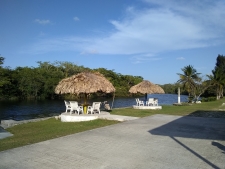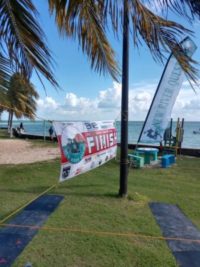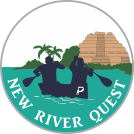ABOUT THE RACE
The event is a 2-day multi-craft paddle race on the New River. Our Belizean standardized 20 ft canoes is the only class that is categorized since this is most popular among our paddlers. The race has potential to grow and as the other paddle crafts types become numerous, they too will have their own categories. The race is scheduled during the Pan-American Holiday weekend (Sat – Sun) in October. The event is managed and organized by several canoe enthusiast volunteers.
The event is sanctioned by the Belize Canoe Association (BCAnoe). What does this mean? Basically, the most important factor is that the race has a supervisory authority, the race meets standards and guidelines set out by BCAnoe, the race uses BCAnoe rules with slight variations, all participating members will receive benefits including points towards their Paddler of the Year accumulation.

Lamanai Riverside Retreat
Day 1 Saturday, starts at the Hill Bank Field Station on the New River Lagoon, it passes the Lamanai Archaeological site just before entering the New River. Once on the river, the route will be marked because there a many paths, teams are to travel along the marked route. During the first day on the scenic New River, the race passes through Shipyard, a Mennonite Village, it then passes through Guinea Grass Village expect lilypad, ASR-BSI Sugar Factory before in breaks for the overnight at the Lamanai Riverside Retreat in Orange Walk Town. To complete day 1, teams will notice a red arch or two red buoys on the left side of the river, they are to paddle beyond that to for a few yards to make a left turn around another single buoy, they then paddle back up towards and passing under the red arch or between those same 2 red buoys where your time stops. If you’re lucky, you’ll get to see some crocodiles and other wildlife along the route. This is a distance of about 45 miles (72km).
NOTE: The Bank Field Station, is located on the Rio Bravo Conservation and Management Area (RBCMA). Getting to the location you’ll need to be granted access. The race organizers will obtain these accesses for teams that are completely registered. Register early. Fans wishing to see the start of the race should contact Programme for Belize to gain entry.

Rainbow Park
Day 2 Sunday, the race continues from Lamanai Riverside Retreat on the New River passing through San Estevan Village, here you see a hand cranked ferry. A short distance after, the river breaks into a Y, the route is to the left side which is shorter which takes you through the village of Caledonia. After Caledonia, there is another Y on the river, again keep left. You’ll continue on the Estrella and a few minutes later another village Libertad, here you’ll see the old Libertad Sugar Factory. Continuing along the river you’ll meet another Y, keep on the right which is the wider path, then again a yards down another Y keep on the left which is the wider part of the river. Just down from there you’ll pass Pueblo Nuevo Ferry. A few minutes later, you’ll exit the mouth of the New River entering the Caribbean Sea at the Corozal Bay. Turn left, use your best judgment on navigating the sea, if you are uncertain and in fear of capsizing, stay close to the shore so you can easily get right side up to continue, either case, paddle towards Tony’s Inn Pier an Orange Buoy will indicate where this is, teams are to paddle between the buoy and the pier, This is part of the course. Another Orange Buoy will indicate the end of the sea paddle, at Rainbow Park in Corozal Town. To finish this race, both paddlers must carry their canoe/kayak out of the sea (Red and Yellow portage flags will indicate the exit) and on shore, crossing under the finish banner which is across the street at Tortuga Grill and Paddle Lounge. This is a distance of about 37 miles (60km).
SPECIAL NOTE FOR ICF K1: Since the K1 is a flat water racing kayak, the Pueblo Nuevo Ferry will be the finish line for this craft only. This is the last viewing point before enter the sea.
Small Craft Warning: In the event there is a small craft warning issued by the authorities or the sea is extremely rough, only then the entire race will be called at the Pueblo Nuevo Ferry. The ceremony will still take place at Corozal Town.
What to expect:
- At the start in the New River Lagoon if the wind is up, expect some waves,
- entering New River, very minimal water current, almost dead water, lilypad by Guinea Grass Village
- and of course once entering the Caribbean Sea salt water and more waves.
The Race has three portages. The first is on day one which is 0.6 mile. It starts at the Lamanai Eco-Tours/Bat’s Landing unto the Phillip Goldson Highway, across the Toll Bridge, down the stairs which is immediately after the bridge, ending at Olfert & Son’s. This portage will be known as the “Highway Run”.
The second portage is 0.23 mile on day two at San Estevan Village, from the Lion’s Den compound taking on the street to the ferry. The portage is nicknamed, “San Estevan Portage”.
The third portage also on day two is about 185 feet from the sea to the finish line located at Tortuga Grill and Paddle Lounge to complete the race.
The portage limits are identified by a portage flag which is diagonally divided Red and Yellow, with the exception for the finish line where two Red flags indicate the finish. Teams are to remain on the designated path of the portage.
Another portage (1.2 miles) maybe introduced in the future.
Since we’re all heading to Hill Bank on Friday for the campfire (weather permitting) pre-race discussion, Hill Bank will allow for camping. If you don’t feel like camping, cabanas and dorm facilities are available at a discounted rate. Food will be available for sale on Friday evening and breakfast on Saturday morning before the race. Kindly make arrangement for meals in advanced.
In Orange Walk, if you want to stay on site, the Lamanai Riverside Retreat compound allows camping for $10 a night. There are also four cabanas available if you choose not to camp. These cabanas will be available to teams at a discounted price. Only four available so act quickly. If you want to go offsite into town there are hotels and restaurants available nearby.
The race has these eight (8) Canoe Categories. Teams may register and compete in one (1) Category only. All teams from all categories compete to be the overall Champion Winner. The Categories are as follows:
- Men’s Combined Ages 20 – 39: Both team members must be male with total combined age being between 20 and 39 years inclusive.
- Men’s Combined Ages 40 – 69: Both team members must be male with total combined age being between 40 and 69 inclusive.
- Men’s Combined Ages 70 – 99: Both team members must be male with total combined age being between 70 and 99 inclusive.
- Men’s Combined Ages 100+: Both team members must be male with total combined age being 100 years or greater.
- Co-ed Combined Ages 20 – 49: Team members shall have 1 male and 1 female member with total combined age being between 20 and 49 years or inclusive.
- Co-ed Combined Ages 50+: Team members shall have 1 male and 1 female member with total combined age being 50 years or greater.
- Women’s Combined Ages 20 – 49: All team members must be female with total combined age being between 20 and 49 years inclusive.
- Women’s Combined Ages 50+: All team members must be female with total combined age being 50 years or greater.
The race is not only limited to the above canoe categories, if you want to participate, bring your kayaks (K1, Surfski, recreational, sit on tops), stand up paddle boards. Once its a paddle craft, its welcome! (as these other paddle crafts become numerous, they will have their own categories)

BCAnoe Racing Number
Since this is a Belize Canoe Association (BCAnoe) sanctioned event a BCAnoe Racing Number will be assigned to your team. You will be notified of this number. You will receive your number with your registration package. The number is to be placed at the bow of the canoe or paddle craft.
If you already have a racing number, please indicate so at the time of registration.
For the very first time in Belize, canoe spray skirts and deck covers will be allow in a race.
The spray skirt or deck cover is a flexible waterproof cover for a your canoe or kayak, with holes for the passengers’ waists. Spray decks are used to prevent water from entering the boat while allowing person to paddle.
Spray decks are used in breaking waves in inclement weather, and in splashy sports. Since the race enters the Caribbean Sea, a spray skirt or cover will be very helpful.
A spray skirts and deck are made of water-tight cloth. It is sized to fit over the opening, or cockpit, of the canoe or kayak, with holes for the waists of the passengers. The spray deck generally seals around the rim of the cockpit and around the torso of each paddler.
Each opening in a spray skirt must make a fairly watertight seal. The seal varies in quality. The deck can be made to seal in several ways, including elastic fabric, a hem containing an elastic cord and/or drawstring, and both.
Nylon (umbrella material) can be used to make your skirt or deck covers. You can also improvise and use thick plastic and duct tape or any other material.

MyLaps timing maps set out to capture athletes time from their ankle brackets. Time is registered when they cross over the mats. Photo: Race Day Events
We have partnered with Race Day Events to time our event. A MyLaps Timing System is use to time our race. This system uses Radio Frequent Identification (RFID) signals to capture the athletes’ times through a timing chip worn around their ankle or can be on their person. The captured time is wirelessly sent to their scoring database allowing the timer to provide fast, accurate results.
To our knowledge our first event in 2018 was the first to utilize this technology and up to April 2019 the only event in Belize. We are taking racing timing to a new level.
Register early so we can get your team in the database.
Registration will ONLY be done online Here. Registration remains open until Friday, October 4th, 2019. There will be no late registrations. Below is the registration schedule, register early, pay less.
| REGISTRATION PERIOD |
SOLO PADDLER ENTRY |
DUAL PADDLER ENTRY |
| From now until end May, 2019 |
$35 |
$50 |
| Months of June and July, 2019 |
$55 |
$100 |
| August and September and up to the Friday, Oct 4th, 2019 |
$75 |
$150 |
| Registration Ended |
- An overall championship trophy will be awarded to the team in each class which completes the race in the least time. These are: Canoe, Kayak and SUP
- 1st, 2nd and 3rd place positions in each category will receive a trophy and medal
- All other participants will receive a participatory token
- Other surprised awards will be presented
- All competitors shall present themselves at the awards ceremony to receive their awards
Day 1 – Saturday, October 12, 2019: 6:30 am
Day 2 – Sunday, October 13, 2019: 7:00 am
Below is a list of the popular viewing and service (pit) locations with estimated times (hr:mm) the 1st crafts should arrive or passing by.
Day 1 Saturday:
- Hill Bank Field Station (0:00)
- Indian Church Village (2:00)
- Shipyard Village (4:00)
- Guinea Grass Village (4:40) (CHECK POINT LOCATION)
- Lamanai Eco-Tours/Bat’s Landing (5:30) (Highway Run Portage starts)
- Olfert & Son’s at Toll Bridge (5:40) (Highway Run Portage ends)
- 1st Bypass Bridge (6:20) (viewing only)
- Lamanai Riverside Retreat (6.30)
Day 2 Sunday:
- Lamanai Riverside Retreat (0:00)
- The San Estevan Bridge (0:03)
- 2nd ByBass Bridge (0:22) (viewing only)
- Lion’s Den at San Estevan Village (1:15) (San Estevan Portage starts)
- San Estevan Ferry (1:20) (San Estevan Portage ends)
- Caledonia Village (2:20)
- Estrella Village (3:25)
- Libertad Village (3:40)
- Pueblo Nuevo Ferry (4:55) (End of race for ICF K1 ONLY)
- Tony’s Inn & Beach Resort (6:15) (buoy location)
- Corozal Town coast line
- Rainbow Park (6:30) (Finish line portage starts)
- Tortuga Grill and Paddle Lounge (6:32) (Race Ends)
Click HERE to see map!
It’s the responsibility of all participating teams to provide their own equipment, gear and for their transportation. Teams are to provide their own supplies, meals, accommodations and all that is required of them. In addition, all teams and their support crew are responsible to keep the areas they use clean and in proper order.
